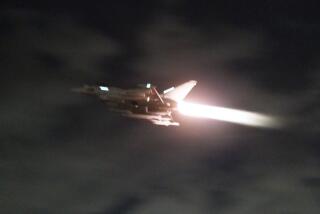U.S. Discovers Mines in New Area of Gulf
- Share via
MANAMA, Bahrain — U.S. warships warned commercial vessels away from a major Persian Gulf shipping route Monday after the U.S. destroyer Kidd reported sighting several mines off the coast of Dubai at the southern end of the waterway.
It was the first time that mines have been sighted so far south in the gulf, and their appearance clearly posed a new challenge to the Reagan Administration’s avowed aim of safeguarding freedom of navigation through the vital waterway, diplomats said.
Gulf-based shipping sources said the mines were sighted Sunday about 20 miles north of Dubai, in a deep-water channel used by nearly all oil-laden supertankers leaving the gulf. They added that the mines were anchored to the seabed, suspended beneath the surface at a depth where a deep-draft tanker might strike them.
“Clearly, they were meant to be hit by a tanker. They were not meant merely as a warning,” one gulf-based shipping source said.
There were conflicting reports, however, about the number of mines involved and the progress of the U.S. Navy’s efforts to locate and dispose of them.
The shipping sources said that up to six mines had been sighted and that U.S. warships had fished three of them out of the water by late Monday. However, Pentagon officials in Washington said they could only confirm sighting three mines, adding that shipping had been warned away from the danger zone.
The area where the mines were seen is almost due north of Dubai and about l5 miles southeast of Abu Musa, a small island where Iranian Revolutionary Guards maintain a naval base.
The Iranians were widely assumed to have planted the mines, probably within the 24-hour period preceding their discovery, in response to continuing Iraqi attacks on Iranian shipping at the other end of the gulf, diplomats said.
However, the Iranians may also have “chosen this particular time and place” to threaten shipping in reprisal for last week’s attack by U.S. forces on an Iranian ship caught laying mines about 200 miles farther up the gulf off the Qatari coast, one Western diplomat said.
The 20-mile-wide channel where the mines were seen runs between the exclusion zone that Iran has declared around Abu Musa and the shallower waters along the Dubai coast, forming a maritime bottleneck through which all deep-draft tankers must pass. These include the reflagged Kuwaiti tankers that the U.S. Navy is escorting up and down the gulf.
Whatever the motive, the effect on international shipping was deeply unsettling, for it confirmed fears, first felt when several mines were seen outside the gulf last month, that the war was being expanded to areas previously considered safe for commercial tanker traffic.
“This has put the fear of death into everybody around here because it means that no place is safe anymore,” a Dubai-based shipping executive said.
Mines have now appeared up and down the length of the 550-mile-long waterway, as well as in the Gulf of Oman on the southern side of the Strait of Hormuz.
Reliable sources said that trying to cope with this threat was putting a serious strain on the U.S. Navy’s capabilities in the gulf.
U.S. forces tracked the Iran Ajr, the Iranian naval vessel caught laying mines off Qatar last Monday, with sophisticated surveillance techniques to be sure it was laying mines before attacking it.
Now, one source said, “we are tracking a whole lot of vessels to see if they are carrying mines and our resources are being stretched to the limit.”
There was help from British minesweepers, which, according to United Press International, began operations in the gulf for the first time Monday. A Ministry of Defense spokesman in London said Royal Navy minesweepers were operating in the gulf but declined to give details.
Since July, when U.S. warships began accompanying 11 reflagged Kuwaiti tankers through the gulf to protect them against Iranian attack, the U.S. role in the region has grown from a simple escort mission into a broad and open-ended commitment to safeguard international shipping in the waterway.
This commitment was reiterated, both publicly and in private, by Defense Secretary Caspar W. Weinberger, who left Cairo for Washington on Monday after a four-day visit to Saudi Arabia, Bahrain and Egypt.
According to Sam A. Zakhem, the U.S. ambassador in Bahrain, Weinberger stressed, in his talks with Bahraini leaders, the Reagan Administration’s “determination” to safeguard shipping in the gulf and to “stand by” its friends in the region, the small Arab gulf states that feel increasingly menaced by Iran.
“We will do our best to defend them against any spillover of the Iran-Iraq War,” Zakhem told reporters.
Conceding that many of these states still have doubts about Washington’s resolve to live up to this promise, if it should evolve into a long-term commitment and cost American lives, Zakhem said the defense secretary presented the leaders he met with a letter from President Reagan stressing “our determination to keep the course and not to turn tail and run.”
Weinberger, who during his tour seemed to take a more hawkish approach towards Iran than has Secretary of State George P. Shultz, emphasized the U.S. military commitment to the gulf states, Zakhem added.
“He was the right spokesman for the right policy at the right time,” the ambassador said.
Asked why the United States was focusing on Iranian attempts to disrupt shipping, while more or less ignoring Iraqi attacks on shipping going to and from Iran, Zakhem said the Administration draws a distinction between Iraqi attacks against civilian vessels inside the “exclusion zone” that Iraq has declared around Iranian ports in the northern gulf and Iranian threats against ships in international waters throughout the rest of the waterway.
More to Read
Sign up for Essential California
The most important California stories and recommendations in your inbox every morning.
You may occasionally receive promotional content from the Los Angeles Times.













